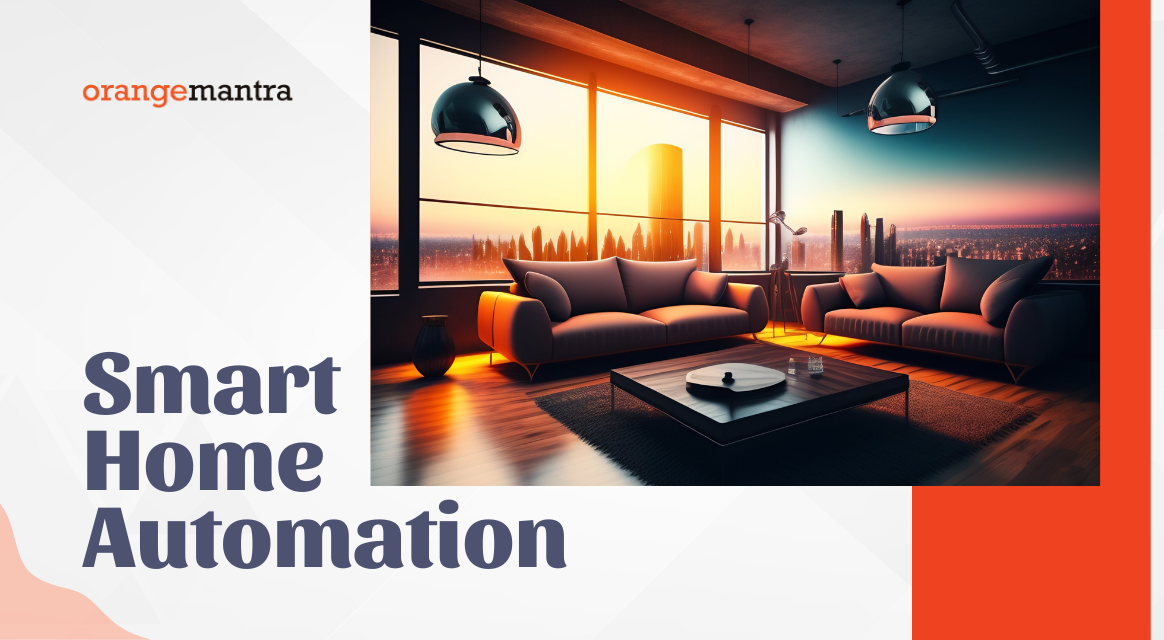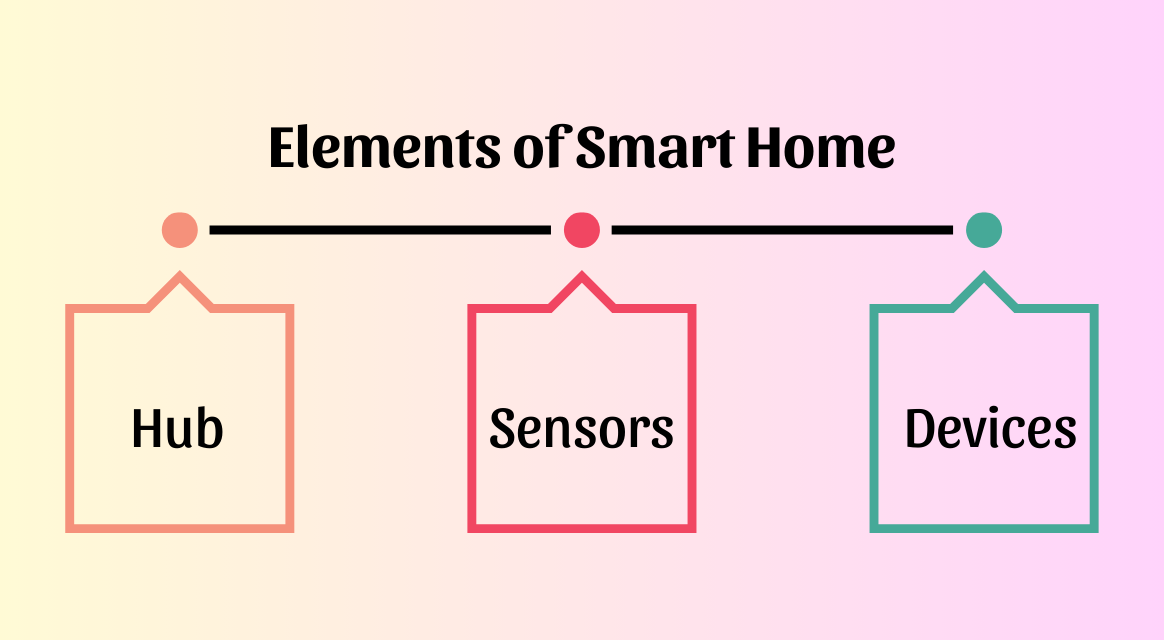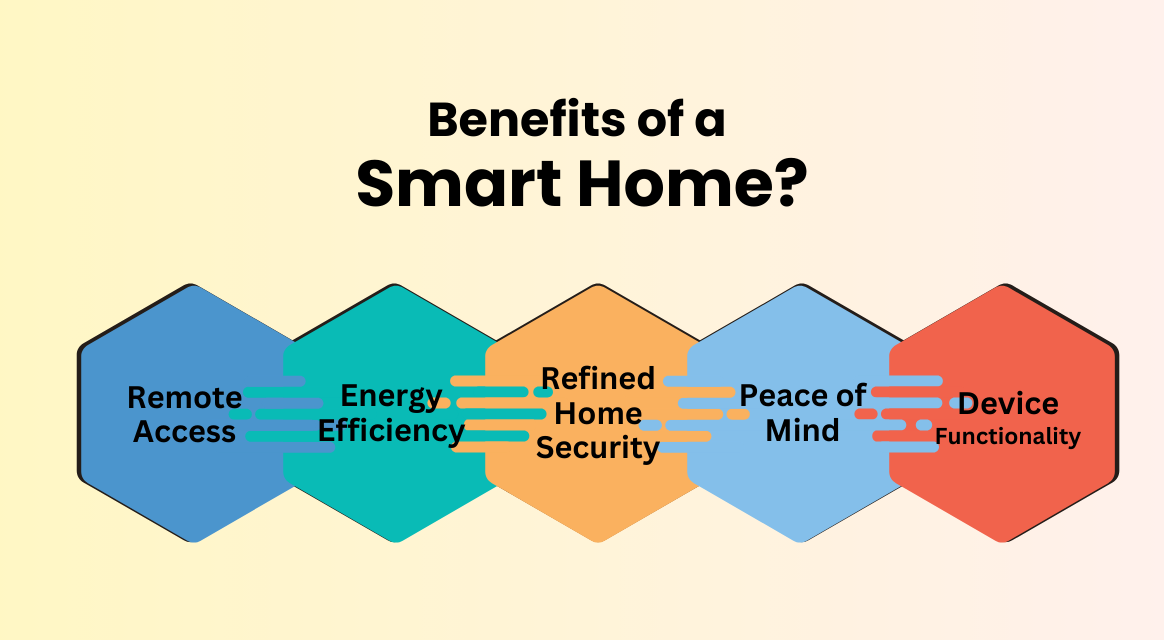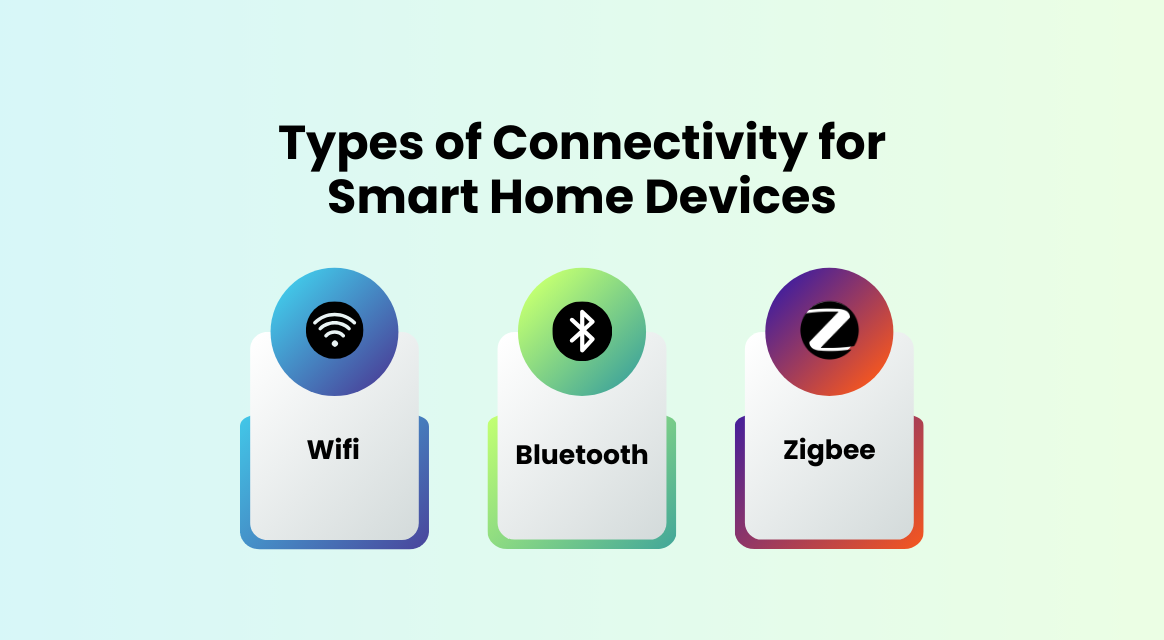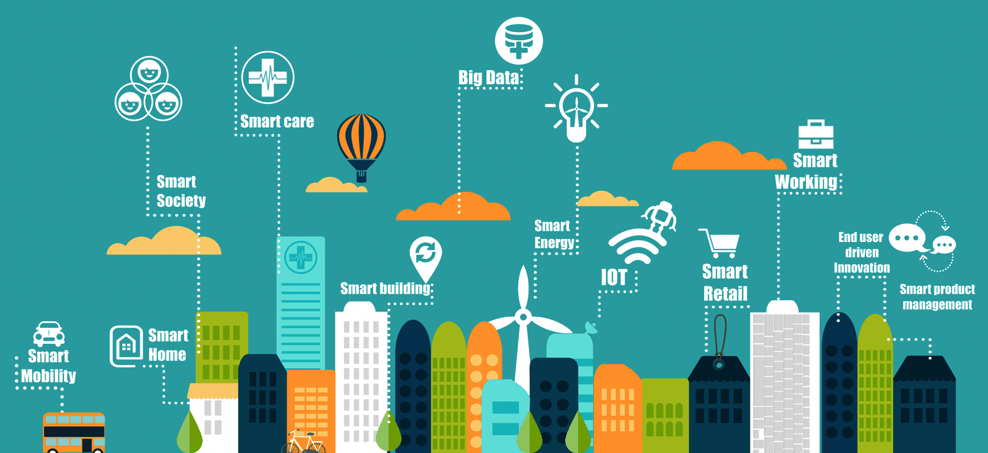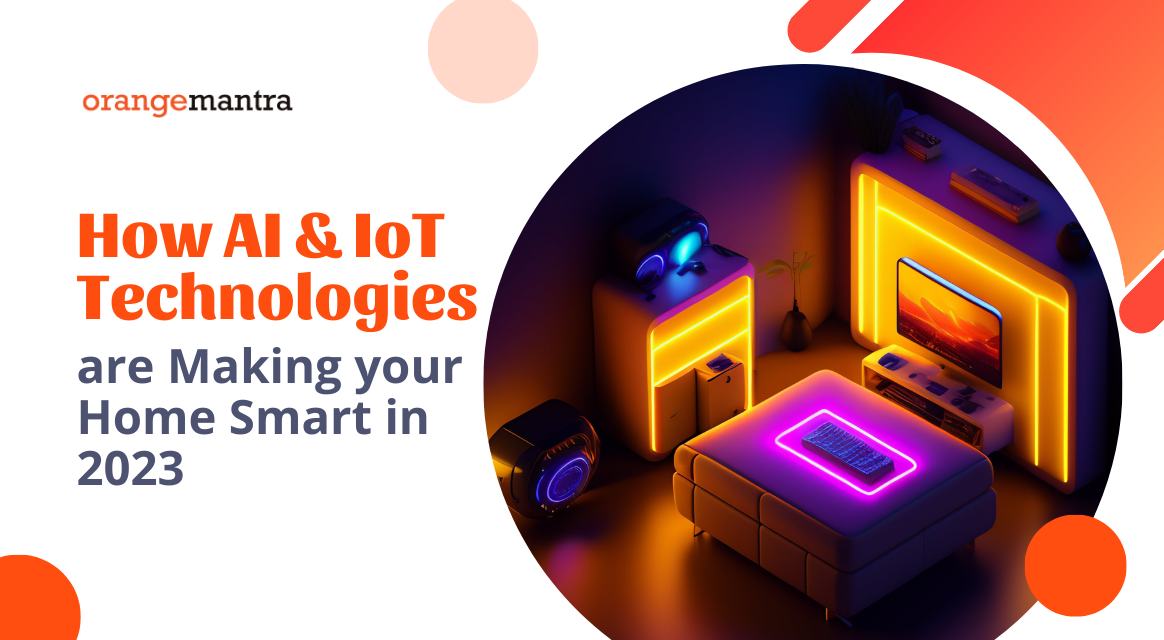
The blog explains how AI and IoT work together to create smart homes that automate daily tasks, enhance comfort and security, and improve energy efficiency by connecting devices, analyzing data, and enabling remote control for smarter living.
- Connected Automation & Control: AI and IoT link smart devices (lights, thermostats, appliances, sensors) allowing homeowners to automate and remotely manage their homes for convenience.
- Enhanced Security & Monitoring: IoT-enabled security systems with AI analytics provide real-time alerts, facial recognition, and proactive threat detection.
- Energy Efficiency & Optimization: AI analyzes IoT data to optimize energy use, lowering costs and improving sustainability through smart thermostats and automated systems.
Building a smart home is not a buzz and luxury anymore. We have completely changed our lifestyle with the presence of smart devices and their impact on society. Technology is becoming an integral part of our lives to a great extent.
With the presence of emerging technologies like the Internet of Things (IoT), Artificial Intelligence (AI), and AR/VR building a smart home becomes even more streamlined. Indeed, these technologies have become a powerful solution to address daily tasks in a flawless manner.
Table of Contents
Is Your Home “Smart”?
Are you staying in a home where you can remotely manage your devices using an application? A Smart Home allows its inhabitants to control them connected devices through a mobile app. They can communicate with one another using sensors and can make decisions themselves using AI.
They can be programmed to follow your rules, whether having wireless or wired connectivity. Leveraging home automation services is becoming popular to create powerful solutions for everyday tasks. The advancement in technology has resulted into affordable home automation tools. How building a smart home and how it save you money and energy consumption? Let’s discuss it in detail in the below section of the blog post.
What is Smart Home Automation?
Home automation is the process to automatically control connected home devices. These devices are internet connected and managed remotely via a mobile app development . Instead of manual control, AI and IoT helps to control the devices via proper communication.
A major example, turn on lights automatically when you enter a room and manage AC temperature before you return home. All this has become possible with the home automation app bringing a convenient and comfortable living experience for users.
Elements of Smart Home
A smart home setup includes three key elements including hub, sensors, and devices. All operate through a communication protocol like Wi-Fi, or Bluetooth from remote location to exchange data.
1- Hub
It is the brain of a smart home that manage communication between the apps and devices. It works in two phases that is back end and the client app to automatically manage devices.
2- Sensors
These are IoT powered devices that detect environmental factors like temperature and other parameters to send info to the hub for appropriate decisions.
3- Devices
Smart TVs and other home appliances works as per the hub’s commands.
What Are the Benefits of a Building a Smart Home?
For people that are interested in making their home smart, there are some prominent reasons to invest now.
1- Remote Access
You can remotely access your devices with a smartphone app to make them work as per your needs. The app can be used around the house to control and manage the cameras, home appliances and digital locks when you are away from home.
For example, with home smart app, you can manage the devices without going to the control panel. The app gets instant notification when you forgot to lock the door and you can lock it remotely. This is a very basic feature you can expect when you have a smart home.
2- Energy Efficiency
Smart home helps to make your space energy-efficient. You can have a complete control on the heating and cooling temperature with a smart thermostat. It can easily analyze your schedule and temperature requirements, and recommend energy efficient settings.
Lights and other energy consumption devices can be managed using a mobile app to switch as per your mood. You have options of evening mode when sun sets, or lights can automatically turn on when you enter the room. All this helps to save energy and reduce bill charges.
Want to Build Smart Homes with AI & IoT?
Our experts help you integrate AI and IoT technologies to create secure, intelligent, and energy-efficient smart home solutions.
3- Refined Home Security
Security features becomes more advanced with the presence of home automation.
You can incorporate security and surveillance features to stay safe. There are several options available which are currently being explored. For instance, home automation applications can connect motion detectors, automated door locks, surveillance cameras, and other devices in your home.
You can also receive security alerts on different devices instantly when alarm goes off, and monitor any intrusion in real-time. You can mange from any location using the app around the globe.
4- Improves Peace of Mind
Home automation technology brings peace of mind for people. If you are confused whether you closed the bedroom door after you left, you can easily monitor from the app. Features of geofence can help to close doors, all external doors, and turn on or off the lights once your phone, crosses certain distance.
A real-time example, if you’re concerned about frozen pipes during the winter season, sensors will share instant information when there is a risk. Plus, several smart baby monitors are available to monitor your loved ones including sleeping newborn or old people. All these home automation solutions brings peace of mind for the people.
4- Improved Device Functionality
Home automation can help you run your appliances in an efficient and better manner. Smart appliances like internet connected TV will find better apps and channels to recommend you. A smart oven will manage temperature and time to cook to perfection without worrying about any mistake.
Smart home theater brings best collection of movie and music in an effortless manner when you want to get entertained. Ultimately, connecting the appliances with internet for automation will surely improve the appliance effectiveness. In the end, your home life is easier, personalized and enjoyable.
Types of Connectivity for Smart Home Devices
1. Wi-Fi
It is a common and popular communication protocol to connect home devices to a hub. Wi-Fi is an integral connectivity component for home automation. It becomes easy for the user to mange their appliances from anywhere using internet. The real challenge is the high energy and data consumption that will generate high bills.
2. Bluetooth
Bluetooth is another connectivity model for smart home devices to connect to each other and a mobile app. The best part of Bluetooth is that it is cheaper in comparison to Wi-Fi and consumes less power. This is the major reason why Bluetooth devices are cheaper and highly competitive. With low range offering, many user skip Bluetooth usage. A user can’t control the devices from a specific distant location and devices should be close to the hub for signal strength.
3. Zigbee
Zigbee is basically a protocol preferred for its affordable pricing by smart home devices. The limitation of Zigbee is that it uses a frequency like Wi-Fi and Bluetooth but other devices in the same frequency can trigger interference.
Features of a Smart Home Automation Application
1- Modernizing Remote Control
The concept of remote control has undergone a significant evolution in the contemporary digital landscape. Smart home applications have redefined the way we oversee our homes by offering the ability to control a multitude of devices from virtually any location across the globe through our smartphones. Whether you’re at your workplace, on a relaxing vacation, or simply in the comfort of your home, you can assert comprehensive authority over a plethora of smart devices. This surpasses mere convenience; it delivers a profound sense of assurance. Concerns about inadvertently leaving the lights on or neglecting to secure your door become relics of the past, all thanks to a mere few taps on your smartphone.
2- Redefining Voice Commands
Smart home applications introduce a groundbreaking innovation: integration with voice commands. Many of these applications effortlessly cooperate with voice assistants such as Amazon’s Alexa or Google Assistant, enabling you to manipulate your smart devices and appliances using your voice, effectively providing you with a personalized digital assistant. Whether you aspire to dim the lights, fine-tune the thermostat, or enjoy your favorite music, it’s all within your reach with a simple voice command. It’s a fusion of unparalleled convenience and unparalleled sophistication.
3- Enhanced Home Security
Home security takes precedence in the realm of building a smart home applications. They offer features like real-time camera surveillance, motion sensing, and intelligent locking mechanisms. You can vigilantly supervise your property, even from a distance. In the event of any suspicious activity, instant alerts are dispatched, empowering you to take swift action or communicate with the appropriate authorities. The inclusion of smart locks adds an additional layer of security by granting remote control over the locking and unlocking of your doors. No longer will you be plagued by concerns about whether you have secured your home – the smart home application has your back.
4- Efficient Energy Management
In an era where the preservation of energy is of paramount significance, smart home applications offer an ingenious solution. You can schedule the operation of your heating, cooling, lighting, and appliances to coincide precisely with your needs. For instance, your thermostat can lower the temperature when you are away at work and subsequently warm your abode just prior to your return. The same principle is applicable to your lighting system. This not only results in tangible cost savings but also fosters an environmentally conscious way of life.
5- Tailored Customization
Smart home applications acknowledge the individuality of each dwelling. They provide an extensive degree of customization, affording you the ability to fine-tune the settings to harmonize with your specific preferences. You have the authority to adjust how your smart devices function and specify the manner in which notifications are conveyed. Whether your inclination leans towards a gradual dimming of lights in the evening or receiving text notifications in lieu of emails, the power is vested in your hands. This level of customization bestows a distinctly personal touch to your smart home, rendering it genuinely your own.
6- Seamless Interconnectivity
The genuine brilliance of smart home applications resides in their capacity to foster synergy among your smart devices. These devices no longer operate in isolation; they communicate seamlessly with one another through the central control hub furnished by the smart home application. For example, your smart thermostat can collaborate seamlessly with your smart blinds. When the thermostat detects escalating temperatures due to direct sunlight, it can promptly signal the blinds to obstruct the sun’s rays, thereby maintaining a pleasant atmosphere within your dwelling. This level of interconnectivity enhances your overall comfort and maximizes your energy conservation efforts.
7- Robust Notification System
Smart home applications keep you thoroughly apprised and in control through a robust notification system. Whether it’s an unlocked door, an open window, or the detection of smoke, you’ll receive immediate notifications on your smartphone. It’s akin to having an additional set of vigilant eyes and attentive ears safeguarding your abode, even when you are absent. This notification system assumes a critical role in ensuring home security and bestowing peace of mind.
8- Compatibility
One of the major merits of smart home applications is their compatibility with a vast array of devices and systems. This compatibility ensures that you can effortlessly link and oversee all your smart gadgets, irrespective of their brand or system. Whether you’re dealing with smart lighting, thermostats, security cameras, or any other smart device, a compatible smart home application serves as a unifying bridge, obviating the necessity for multiple disparate applications. Instead, you have at your disposal a user-friendly hub for the management of your smart home.
Conclusion
The future of home automation technology is bright and its adoption will grow significantly as more people will get to know its benefits. Building a smart home system using AI development solutions & IoT technologies is a real challenge from security, and user experience. To build a successful all in one smart home app, you need to consider several aspects, you’ll be using a platform to its architecture and security.
We advice you to outsource smart home app development, it will help you build app at a faster rate and even keep you in budget. They will integrate best features into the app and even suggest what is in the trend.
At OrangeMantra, we have deep expertise in building IoT development solutions for smart homes. If you’re looking for building a smart home automation system, we are the right fit for your business needs as a development partner.
Frequently Asked Questions
-
What is smart home automation?
“Home automation” is the method to control household devices, activity, and other appliances. In simple terms, you can control the utilities and features of the home appliances to make life more convenient and secure by saving household bills.
-
How IoT is useful in smart home automation?
With the addition of IoT in the home automation ecosystem, it becomes simple to control your home devices. You can simply monitor and even manage home attributes like lighting, climate, music systems, and other appliances. It is really helpful to control home devices from any location.
-
Which industry you serve with your IoT app development services?
Our company serve industries of all types and sizes. We build solutions for a retail store, home and office space looking for automation. We serve small, medium, and large enterprises.
-
Do you have any home automation app support service?
Yes, we sign a strict NDA sharing all details related to the long-term support. Our app development experts address issues faced with home automation solution by our clients. We have a 24/7 support team to run and maintain applications.
-
How much time is needed to build a home automation app?
The time to build a home automation solution is based on the business requirements and application goals. Our team of developers keep a proper check on all stages of the application development. After analysis of every factor time estimation is shared with the client.

